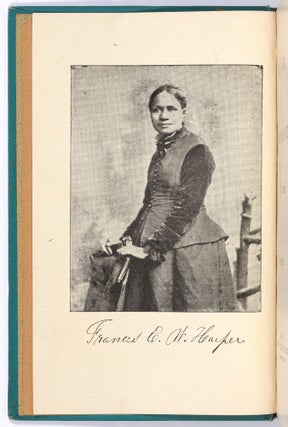Boston: James H. Earle, (1892).
Sold
Hardcover. Stated third edition. Blue decorated cloth stamped in black and gilt. Frontispiece portrait of the author. Introduction by William Still. Later bookplate of George and Wilma Edwards, front hinge very neatly strengthened, small nick on front fly, a very near fine copy with just the slightest of rubbing and with the gilt bright and unrubbed.
The only novel by Harper, better known for her poetry and essays, this was long considered the first novel to be published by an African-American woman, until Henry Louis Gates, Jr. advanced the cause of Harriet E. Wilson's *Our Nig* (1859).
Although this novel contains many conventional elements, it also concerns itself with the personal independence of women of color, and particularly of the race in general. The protagonist, the daughter of a wealthy white father, is unaware that her mother is not only of mixed race, but also the property of her husband. Iola and her brother and sister lead lives of privilege in North Carolina and at an expensive boarding school until her father dies, when her uncle claims them as slaves. Soon liberated by the Union Army, she offers her services as a nurse, and attracts the attentions of a white doctor, who discovers she is of mixed race, and encourages her to "pass" for white, which she refuses to do, instead setting off to seek her surviving family accompanied by a light-skinned black doctor.
Iola commits herself to the education and furtherance of her race, and particularly of the freed slave, but is especially adamant about maintaining her status as an employed woman, saying at one point: "I think that every woman should have some skill or art which would insure her at least a comfortable support. I believe there would be less unhappy marriages if labor were more honored among women." Iola is also strongly in support of the temperance movement and in the principles of the Women's Christian Temperance Union in particular. While the novel has a conventional ending – Iola marries the black doctor – she continues her educational endeavors and social work as a married woman.
This is the third of only four 19th Century editions. The first two editions published by Garrigue Brothers in 1893; this third edition, published by James H. Earle, which is dated 1892 (but is stated third edition, and was probably published after 1893); and a fourth edition, also published by Earle, in 1895.
Item #443859




